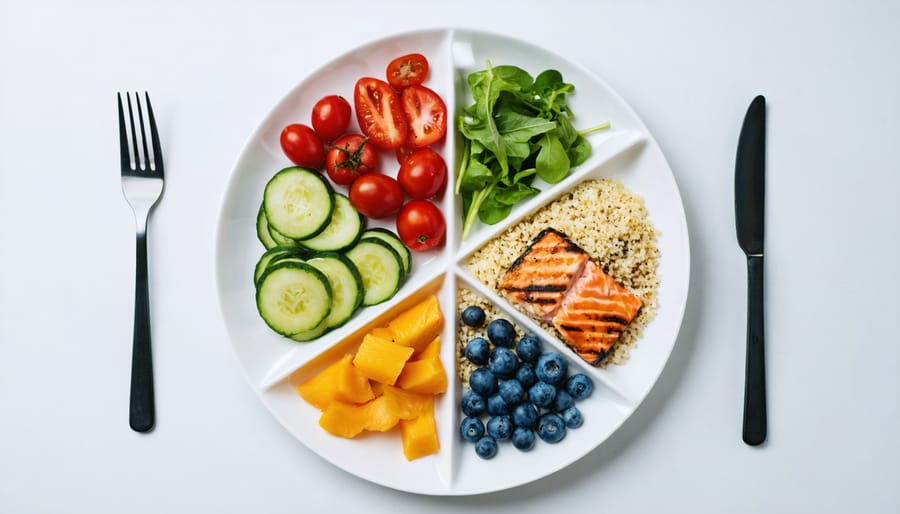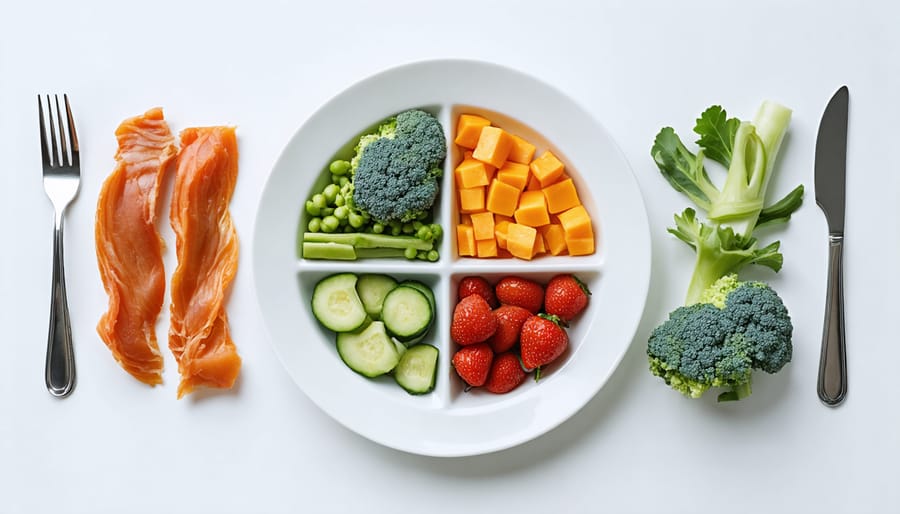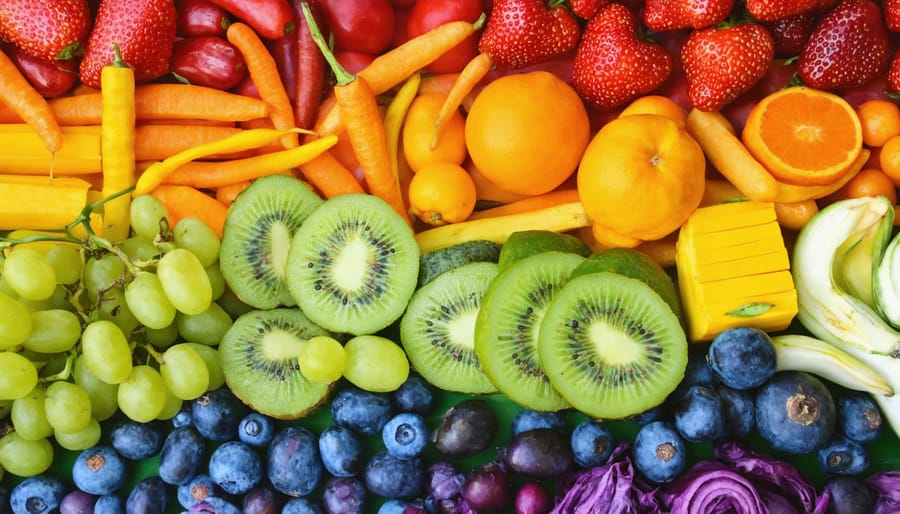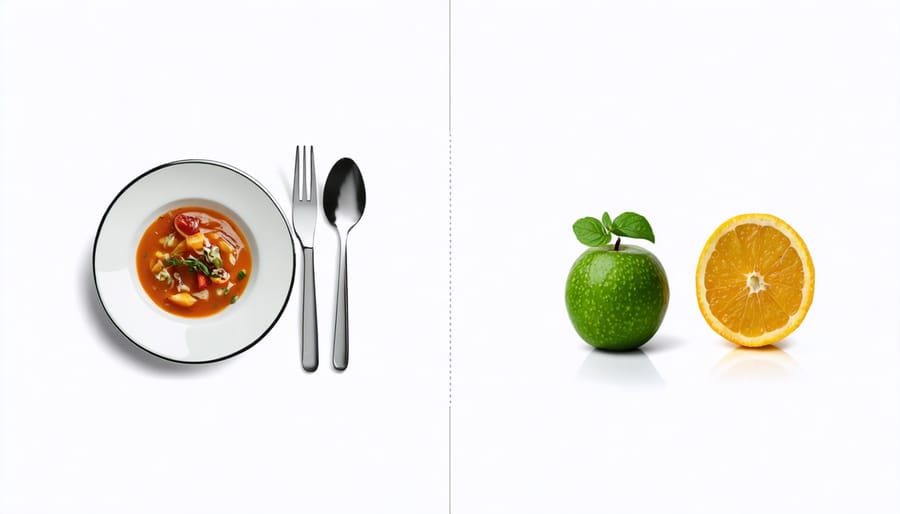
Transform your relationship with food by mastering the art of balanced nutrition – it’s simpler than you might think. A truly balanced meal combines lean proteins, complex carbohydrates, and healthy fats in portions that nourish both body and mind. Through mindful eating practices, we learn to appreciate not just what’s on our plate, but how these nutrients work together to fuel our daily lives.
Think of your plate as a colorful canvas: half filled with vibrant vegetables and fruits, one-quarter dedicated to whole grains or starchy vegetables, and one-quarter reserved for lean protein. This isn’t just about counting calories or following strict rules – it’s about creating sustainable, enjoyable eating habits that energize your body and satisfy your soul.
Whether you’re a busy professional, a dedicated parent, or someone simply looking to make better food choices, understanding balanced nutrition doesn’t require a degree in dietetics. It starts with small, intentional choices that add up to significant changes in how you feel, perform, and thrive in your daily life.
The Art of Building a Balanced Plate

Protein: Your Body’s Building Blocks
Think of protein as your body’s master builder – it’s essential to help nourish your body and maintain everything from your muscles to your immune system. I remember when I first started paying attention to my protein intake; it felt overwhelming! But trust me, getting enough protein doesn’t have to be complicated.
For meat-eaters, lean options like chicken breast, turkey, and fish are excellent sources. A portion about the size of your palm (roughly 3-4 ounces) is perfect for most meals. But here’s something many of my readers are surprised to learn: you don’t need to rely solely on animal products for protein!
Plant-based protein sources are having their moment, and for good reason! Lentils, chickpeas, quinoa, and edamame are powerhouse options that can easily become the stars of your meal. I love adding a handful of nuts to my morning yogurt or tossing some black beans into my lunch salad for an extra protein boost.
For those wondering about portions, aim to include protein in every meal – typically about 20-30 grams. This could look like a cup of Greek yogurt at breakfast, a serving of lentil soup at lunch, or a piece of salmon at dinner. Mix and match these sources based on your preferences and dietary needs – there’s no one-size-fits-all approach!
Complex Carbohydrates: Sustained Energy
Think of complex carbohydrates as your body’s preferred energy source – they’re like the steady, reliable friend who’s always there when you need them. Unlike their simple sugar cousins, complex carbs release energy slowly, helping you maintain stable blood sugar levels throughout the day.
I learned this lesson the hard way during my marathon training days, when switching from sugary breakfast cereals to wholesome oatmeal made a world of difference in my energy levels. The key is choosing the right carbs and portions that work for your body and lifestyle.
Aim to fill about a quarter of your plate with complex carbohydrates like brown rice, quinoa, sweet potatoes, or whole grain pasta. A serving size is typically about the size of your closed fist – though this can vary depending on your activity level and personal needs.
Some of my favorite complex carb options include:
– Steel-cut oats topped with fresh berries
– Whole grain bread with avocado
– Black beans and brown rice
– Roasted sweet potato wedges
– Quinoa-based Buddha bowls
Remember, not all carbs are created equal! Look for foods rich in fiber, which helps with digestion and keeps you feeling satisfied longer. When shopping, check food labels and choose products where “whole grain” is listed as the first ingredient. Your body (and energy levels) will thank you for making these smart carb choices!
Healthy Fats: Essential for Wellness
Let’s break free from the outdated notion that all fats are bad! As someone who once shied away from avocados (can you believe it?), I’ve learned that healthy fats are absolutely essential for our wellbeing. Think of them as your body’s premium fuel source and natural beauty enhancer.
The key is choosing the right types of fats. Extra virgin olive oil, avocados, nuts, and seeds aren’t just delicious – they’re powerhouses of nutrition that help your body absorb vitamins, maintain healthy skin, and keep you feeling satisfied after meals. I love adding a handful of walnuts to my morning oatmeal or drizzling olive oil over roasted vegetables for that perfect balance of flavor and nutrition.
Fish like salmon and mackerel deserve a special mention here. Rich in omega-3 fatty acids, they support brain health and help reduce inflammation. Even if you’re not a big fish fan, you can get these benefits from chia seeds or flaxseeds sprinkled into your smoothies.
Remember, portion size matters – even with healthy fats. A good rule of thumb is to include about 1-2 tablespoons of healthy oils or a quarter of an avocado per meal. It’s not about eliminating fats but choosing the right ones and enjoying them mindfully. Trust me, your body (and taste buds) will thank you for making these nourishing choices!
Colors and Textures: The Visual Balance
Ever noticed how the most satisfying meals are often the ones that look like an artist’s palette? Creating a balanced meal isn’t just about nutrition – it’s about engaging all your senses, starting with your eyes. Think of your plate as a canvas where different colors represent various nutrients your body needs.
I learned this lesson while hosting dinner parties – guests always gravitate toward plates with vibrant combinations like deep green kale, orange sweet potatoes, and purple beets. It’s not just about aesthetics; each color actually indicates different nutritional benefits. Dark greens are rich in iron and folate, while orange vegetables pack plenty of vitamin A and beta-carotene.
But let’s talk about texture – it’s the unsung hero of a satisfying meal. Imagine combining crispy roasted chickpeas with creamy avocado, or pairing crunchy raw vegetables with tender quinoa. These texture contrasts don’t just make eating more enjoyable; they often indicate a good mix of different food groups and nutrients.
Here’s my go-to formula for a visually balanced plate:
– Add at least three different colors
– Include something leafy or green
– Mix in a naturally bright ingredient (think bell peppers or cherry tomatoes)
– Combine at least two different textures
Remember that eating starts with our eyes, and when our meals look appealing, we’re more likely to enjoy them mindfully and feel satisfied. Try photographing your next meal – if it looks Instagram-worthy, chances are you’ve created a good balance of colors and textures that also delivers on nutrition.
Don’t worry about perfection; start small by adding just one new color or texture to your usual meals. Before you know it, creating visually balanced plates will become second nature.

Mindful Portion Control
Let’s be honest – we’ve all had those moments staring at our plates, wondering if we’re eating too much or too little. The good news? Mindful portion control isn’t about strict measuring or feeling restricted; it’s about developing a healthy relationship with our food portions and listening to hunger cues.
Think of your plate as a canvas: half should be colorful vegetables, a quarter dedicated to lean proteins (about the size of your palm), and the remaining quarter for whole grains or complex carbohydrates (roughly the size of your closed fist). For healthy fats, think thumb-sized portions – perfect for things like avocado or nuts.
I discovered this approach after years of overthinking portions, and it’s been a game-changer. Instead of measuring everything obsessively, I’ve learned to tune into my body’s signals. When you’re starting, try this simple technique: before taking seconds, pause for five minutes. Often, you’ll find your body is actually satisfied.
Remember, portion control looks different for everyone. Some days you might need more fuel than others, and that’s perfectly okay! The key is finding your personal balance between nourishment and satisfaction. Start with smaller portions – you can always add more if you’re truly hungry. This mindful approach helps prevent overeating while ensuring you get the nutrition your body needs.
Simple Meal Planning Tips
Making balanced meals doesn’t have to be complicated! I’ve found that spending just 30 minutes each weekend planning my meals saves me hours of stress during the week. Start by creating a simple template for your weekly meals, leaving room for flexibility. I like to keep a running list of family-favorite recipes that I know are both nutritious and delicious.
Stock your pantry with versatile staples like whole grains, legumes, and frozen vegetables. These ingredients are lifesavers when you need to pull together a quick, balanced meal. One of my favorite tricks is to prep ingredients in bulk – for example, cooking a large batch of quinoa or roasting several sheet pans of vegetables that can be mixed and matched throughout the week.
Try the “plate method” when planning your meals: fill half your plate with colorful vegetables, quarter with lean proteins, and quarter with whole grains. Keep healthy snacks readily available, and don’t forget to plan for leftovers! Remember, meal planning isn’t about perfection – it’s about creating sustainable habits that work for your lifestyle.
I’ve learned that the most successful meal plans are the ones that reflect your family’s preferences while incorporating balanced nutrition. Start small, perhaps planning just three days at a time, and gradually build up to a full week as you become more comfortable with the process.

Creating balanced, nutritious meals isn’t just about following guidelines or checking boxes – it’s about nurturing your body and mind while building sustainable habits that last a lifetime. When you prioritize balanced nutrition, you’re investing in your health, energy levels, and mood, which ripples through every aspect of your life. Remember, small changes in your meal planning can lead to significant improvements in your overall wellness journey. By incorporating a variety of colorful vegetables, lean proteins, whole grains, and healthy fats into your meals, you’re not just feeding your body – you’re creating a foundation for lasting vitality and happiness. Start with one balanced meal at a time, celebrate your progress, and watch as these positive choices become natural parts of your daily routine.



